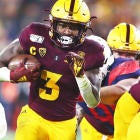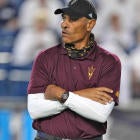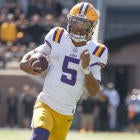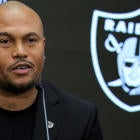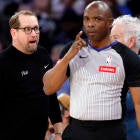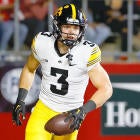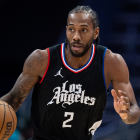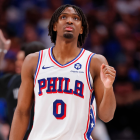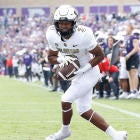Last year, it was Gardner Minshew, Chauncey Gardner-Johnson, and Maxx Crosby. In 2018, Taron Johnson, Genard Avery, and Avonte Maddox. The season before it was Eddie Jackson, Tarik Cohen, and George Kittle. In 2016, the group consisted of Dak Prescott, Jordan Howard, and Tyreek Hill. Those players were all Day 3 draft picks who surprised early on at the NFL ranks. The phenomenon happens every year.
While all the 2020 Day 3 selections listed below aren't guaranteed to flourish as rookies, they have the best chance to make an instant impact due to their refined skill, athleticism, and opportunity on their respective teams.
Curtis Weaver, EDGE, Dolphins
Weaver was phenomenally productive at Boise State, and stat-sheet filling began in his redshirt freshman season as a 19-year-old -- 11 sacks, 13 tackles for loss -- and never subsided. He finished his time with the Broncos with 34 sacks and 47.5 tackles for loss in three seasons. The high-level productivity starting at such a young age is an encouraging indicator of future success for Weaver. He wasn't simply winning due to being older and more physically developed than his competition.
Weaver has a small but effective collection of pass-rushing moves too. Per the Pro Football Focus Draft Guide, Weaver recorded 114 quarterback pressures on his final 650 pass-rush snaps in 2018 and 2019 combined. That's a pressure every 5.7 pass-rush snaps. For context, Chase Young registered 131 quarterback pressures on his final 790 pass-rush snaps at Ohio State, which equates to a pressure every 6.03 pass-rush snaps. Of course, a sizable difference in competition, but Weaver was insanely productive in college.
While not a freaky explosive athlete, Weaver can really flatten to the quarterback, a key (natural) ability that leads to big-play creation for an edge rusher, as opposed to those who can't tightly bend the edge and are repeatedly pushed past the passer. Weaver running the three-cone drill in 7.00 seconds at the combine is the quantifiable evidence for his flattening skill. To hit the threshold on the nose at an ultra-compact 6-2 and 265 pounds aligns closely with similarly stocky defenders Jerry Hughes (6-2, 255 with a 6.99 three cone) and Justin Houston (6-3, 270 with a 6.95 three cone) who've long been successful edge rushers.
In Miami, he finds himself on a rebuilding roster that certainly spent heavily in free agency especially on the defensive side of the ball. However, new defensive end Shaq Lawson is predominantly a run-stopping specialist and Emmanuel Ogbah has never registered more than 5.5 sacks in his NFL career. After those two at the edge-rusher position, the Dolphins have many bodies but loads of uncertainty, giving way to a prime opportunity for Weaver to step in immediately and outplay his draft position.
My EDGE3 and No. 16 overall prospect in the 2020 class has the inherent talent and polished hand work to make a quick splash on South Beach for the Dolphins.
The 2021 draft is a year away, but it's never too early to size things up. The Pick Six Podcast Superfriends, along with the college football experts on our Cover 3 Podcast, break everything down; listen below, and be sure to subscribe for daily NFL goodness.
K'Von Wallace, S/CB, Eagles
Yes, the Eagles traded for star outside cornerback Darius Slay this offseason, however, as a whole, Philadelphia's secondary has a long way to go before it's a truly respectable unit. Many jobs are up for grabs.
Wallace will enter the NFL with a safety label but is truly a slot cornerback who occasionally carried out some free safety responsibilities in Clemson's defense. With 4.53 speed, Wallace is somewhat of a liability running in man deep down the field. But his 38-inch vertical and quick 6.76 three-cone time translates to quick, explosive movements on the field, perfect for dealing with twitch slot receivers at the short and intermediate levels.
As a senior, he defended 10 passes and snagged a pair of interceptions to go along with a hefty 76 tackles. At 5-11 and 206 pounds, Wallace has a compact frame that allows him to play bigger than his size against the run. He's very reliable as a tackler too.
Avonte Maddox has spent time in the slot for the Eagles but kicked outside in 2019. No one else in the defensive backfield has a firm grasp on the new-age safety/slot cornerback position. Wallace has the perfect skill set to be an instant, big-play contributor in Philadelphia's secondary.
Joe Reed, WR, Chargers
Reed is a stocky, yards-after-the-catch monster who bounces off tackles and leaves defenders whiffing at the air like a true feature back. He averaged just 8.8 yards per reception in 2019, yet that low figure was almost strictly due to the way he was utilized at Virginia to accentuate his running back like prowess.
According to PFF's Draft Guide, Reed forced 15 missed tackles on his 77 receptions, a rather high figure for a wideout mostly featured on short passes with plenty of defenders in close. At the combine, Reed exploded with a 4.47 time in the 40 and a 38-inch vertical at a compact 6-0, 224-pound frame.
Sure, Keenan Allen and Mike Williams are the top two wideouts in Los Angeles, but there's a need for a quality No. 3 in Los Angeles in 2020. After Shane Steichen was promoted to offensive coordinator before Week 9, the Chargers utilized "11 sersonnel" (three-receiver set) 73% of their offensive snaps, the fourth-highest rate in football.
Reed was held back by poor quarterback accuracy down the field, and with his sub 4.50 speed, it's not out of the realm of possibility that the mid-round pick could become more of a deep option than he was in college.
Harrison Bryant, TE, Browns
For as much of advocate as I am for the predictive powers on the NFL Combine, each draft season I daringly go out on a limb and label a select few prospects draft crushes who just simply look more athletic than their workouts in Indianapolis.
Bryant is one of those prospects. Despite a rather poor performance at the combine, Bryant finished as my TE1 in a weak class. This year's John Mackey Award winner -- nation's top tight end -- finished with 1,004 yards on 65 receptions, a masterful culmination of a steadily improving three-year stint as a major contributor in Florida Atlantic's offense.
Trait-wise, Bryant explodes out of his stance and when changing directions as a route-runner, and he's one of the few tight ends in this class that truly threatens defenses down the field.
He's a modern-day tight end.
And, although Cleveland signed Austin Hooper to a lucrative deal this offseason and 2017 first-round pick David Njoku remains on the roster, new head coach Kevin Stefanski adores utilizing two-tight end looks, so don't be surprised if Cleveland utilizes a heavier rotation at that position that almost every other team in the league.
Eno Benjamin, RB, Cardinals
In my live grades on the Saturday of the draft, I wrote "no reason for Benjamin to still be on the board this late" when he was picked at No. 222 overall by Arizona.
At Arizona State, Benjamin shouldered a full workout for two seasons and after averaging 5.3 yards per tote on a whopping 300 carries in 2018, his production dipped to just 4.3 yards per carry on 253 rushes in 2019. Individually, Benjamin was a star, and he caught 77 passes in those two seasons, so we know he has reliable hands.
Before a sparkling combine, Benjamin demonstrated stellar elusiveness, contact balance, and vision, the three most vital skills to succeeding at the running back position. In 2018, per PFF, Benjamin forced 84 missed tackles, which trailed only Darrell Henderson and Devin Singletary in college football. On 300 carries, that equated to a forced missed tackle on 28% of his runs. He finished as my RB7 in this class.
Behind a worse offensive line on an offense starting a true freshman quarterback in 2019, Benjamin "only" forced 62 missed tackles, yet given that total came on 231 rushes, his forced missed tackle rate was still 26.8%.
Sure, he's clearly behind transition tagged Kenyan Drake, and there's Chase Edmonds ahead of him on Arizona's running back depth chart. However, the Cardinals have 94 carries and 36 receptions from David Johnson in 2019 that are now up for grabs. Given that almost every team utilizes three runners throughout a season -- particularly if injuries hit -- it wouldn't be shocking if Benjamin got an opportunity as a rookie, and based on his natural talent, it also wouldn't be shocked if he instantly produced.












